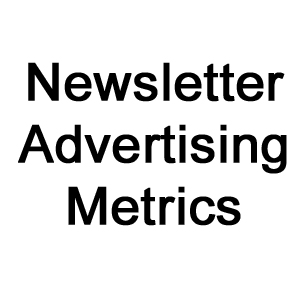 Newsletter advertising has a lot of advantages compared to traditional channels for promotion and marketing, but one of the most beneficial is the availability of testing and measuring tools. Said tools provide the means to gauge the performance of advertisements and let email newsletter publishers present pertinent data to advertisers.
Newsletter advertising has a lot of advantages compared to traditional channels for promotion and marketing, but one of the most beneficial is the availability of testing and measuring tools. Said tools provide the means to gauge the performance of advertisements and let email newsletter publishers present pertinent data to advertisers.
Keys to Accurate Testing
The secret to accurate testing of newsletter advertising metrics is to isolate the factors that are being tested, and to prevent outside factors from changing it. It’s not a new thing, by any means, as the principle of testing requires all variables to be kept constant. When it comes to newsletter advertising, it means that you should show ads to the same audience on a consistent schedule and on the same position on the page. This will limit the influence of other factors on the reader’s response to the ad being tested.
The A/B Split Run Test
The A/B split run test basically requires you to run two different ads each to half of an audience. Print magazines do this by creating slightly different versions of the same issue, with the difference being the ads in a particular location within the issue. It makes it easy to gauge an ad’s effectiveness because the audience, timing, and position of the advertisements being shown are the same.
In the past, A/B split run tests cannot be done on advertisements in email newsletters, with marketers only relying on tracking clickthrough rates for different newsletters published at the same time. The results of this type of test is useful, but less accurate because the different newsletters have different audiences, ad placement policies, and publication dates.
What makes the traditional means of testing for newsletter advertising metrics even more difficult is that it’s hard to discern the correlation between Clickthrough Rates and demographic data. The general demographic data from many range of newsletters available is very broad and make analysis next to impossible.
Newer Testing Tools for Newsletter Advertising Metrics
These days, the importance (and profitability) of email newsletter advertising has been proven, resulting in many publishers coming out with sophisticated tracking and testing tools, finally allowing the use of A/B split run tests and greatly improving the accuracy and relevance of data.
In email newsletters, the A/B split run test is done by having the email ad server insert two different versions of the same ad in each half of a specific run. Each ad is assigned a unique URL, which makes it easy to determine the CTR for each ad. Additionally, the URL can include each reader’s unique profile code, so that each click can also log exactly which reader responded to the ad, making it possible to tabulate demographic and even user-specific data like preference, gender, age or whatever other data you’ve managed to collect during their sign up.
Other Testing Methods
The A/B Split Run Test, while an effective means of testing newsletter advertising metrics, is by no means the only useful testing method. Other variations on the testing can be implemented in order to maximize results. These include approaches such as analyzation of CTRs based on demographic data, comparison of results based on ad positions within the email, the rise and fall over time of response rates when the ad is inserted multiple times, etc. It is important to remember that the process of developing ads online is subject only to the knowledge and creativity of the marketers, and it is usually up to market researchers and their testing methods to gauge market reactions.












Pingback: Newsletter Ads Are Growing | www.admailr.com
Pingback: Gathering Data Through Newsletter | www.admailr.com
Pingback: Bad Newsletter Habits Stunting Growth | www.admailr.com
Pingback: Gathering Data Through Newsletter | Admailr
Pingback: Newsletter Ads Are Growing | Admailr